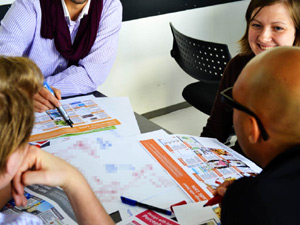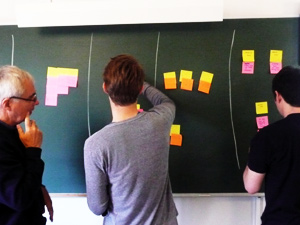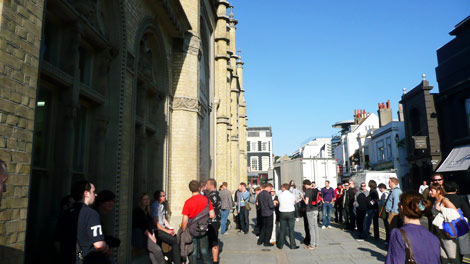
I’m running a workshop on Wednesday 31st August at dConstruct 2011 in Brighton, and I thought it would be worthwhile explaining in a bit more detail what it’s about, and what we’ll be doing.
Here’s the summary from the dConstruct website:
Whether we choose to do it or not, what we design is going to affect how users behave, so we might as well think about it, and–if we can–actually get good at it. Bridging the gap between physical and digital product design, a systems approach can help us understand how people interact with the different touchpoints they experience, how mental models and cognitive biases and heuristics influence the way people make decisions about what to do, and hence how we might apply that knowledge (for good).
In this full-day practical workshop, we’ll try a novel approach to design and behaviour, using ourselves as both designers and cybernetic guinea pigs in exploring and developing a combination of physical and digital experiences. You’ll learn how to improve your own decision-making and understanding of how your behaviour is influenced by the systems around you, as well as ways to influence others’ behaviour, through a new approach to designing at the intersection of people, products, services and systems.
So what will the day actually involve? (You’re entitled to ask: the above is admittedly vague.) I’ve run quite a lot of workshops in the last couple of years, mainly using the Design with Intent toolkit in one form or another to help groups generate concepts for specific behaviour change contexts, but this one is slightly different, taking advantage of a full day to explore more areas of how design and behaviour interact, in a way which I hope complements dConstruct’s overall theme this year of “bridging the gap between physical and digital product design” usefully and interestingly. Also, the concept of ‘design for behaviour change’ is probably no longer new and exciting (at least to the dConstruct audience) in quite the way it might have been a few years ago: a more nuanced, developed, thoughtful exploration is needed. We’ll be using some of the Design with Intent cards throughout the workshop, but they’re not the main focus.
My plan is for the workshop to have four stages (3 shorter ones in the morning, 1 longer one for the afternoon):
1) Exploring cognitive biases, heuristics and bounded rationality in a design context
Through a short group exercise, we’ll investigate our own decision-making and thought processes—biases and heuristics which might mislead us, but which can also help us, in the context of using products and services (and how we assume users may use them). This section attempts to translate ideas which may be familiar from behavioural economics—Kahneman, Tversky, Thaler, Sunstein, Ariely and others—into technology applications, but also includes the work of people such as Gigerenzer and Goldstein, taking a different perspective on the idea of ‘bounded rationality’ and what it might mean when understanding how people really interact with products and services.

2) Black boxes, cybernetics and users’ mental models of systems
I’m not going to give too many details of this stage, since it’ll spoil the surprise. But (in groups) we’ll be trying to work out what’s going on with a set of unknown products—how they work, and how our behaviour (as users) affects what happens as part of a wider system. There will be breadboards, and LEDs, and cardboard boxes (probably not black), and maybe unexpected things. And Post-It notes, I expect.
3) Designers’ mental models of people’s behaviour
Again, I don’t want to give away too much here, but imagine a cross between a Wizard of Oz experiment, metagames, and some of the ideas discussed here. Basically, in pairs we’ll be playing users and products/services intended to influence behaviour, following our own strategies and seeing what happens. The outcomes of this will be compared (in structure if not in content) to some of R D Laing’s Knots, not to complicate them further(!) but to link them back to the systems/cybernetics perspective which emerged from 2).

4) Prototyping tools for understanding users and influencing behaviour
In the afternoon, the aim is—building on the insights from the morning—to create and develop tools for uncovering and understanding how users think and behave (and match these to design strategies), in a system context. We will have a ‘behaviour’ scenario to investigate, and the scope to examine it from different perspectives. Hopefully this will take in the existing knowledge and expertise some participants will have on user research methods, and build on this with some more explicitly behaviour-related insights. The result will be a set of methods and approaches which ought to be useful and applicable outside the workshop wherever understanding and influencing user behaviour, as part of a system, is needed, and which participants have played a part in creating. These will be documented so you’ll have something after the event as a reference.
If all that sounds like the sort of thing you’d find useful and interesting, there are still (at time of writing) a few workshop tickets available, which also get you into the conference. The workshop takes place at Clearleft’s offices at 28 Kensington Street, Brighton. Any questions / suggestions / ideas please do comment below.
Thanks to Clearleft for organising the conference—it’s been great the last couple of years, and I feel privileged to be part of it this year.

PS: Brighton Dome are right to ask you not to sit on the radiators, really. They’re old, and beautiful.


Pingback: dConstructing a workshop | Design with Intent